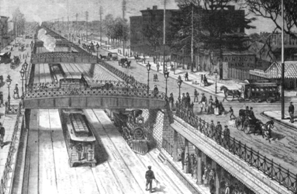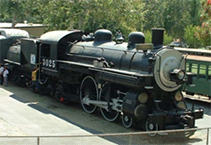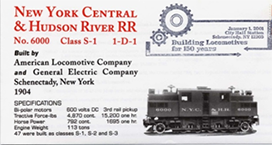Grand Central Terminal
Introduction
A landmark in architecture, urban planning, and rail transport, New York’s Grand Central Station celebrated its 100th anniversary this year. Superlatives for this rail station abound. Paul Goldberger, a leading American architecture critic, proclaimed “[Grand Central] is sublime. It reminds you of the greatness of human ambition.” Necessity, daring and genius made Grand Central possible. Geography set rather rigid boundaries on the growth of rail transport in late 19th century Manhattan. New York City's rapid growth placed enormous strains on the rail transport system serving Manhattan. A tragic accident unleashed an outcry to ban passenger steam rail from the Manhattan landscape. From these circumstances, boldness and imagination produced the wonder called Grand Central Station. And at the center was William J. Wilgus’s brilliant vision to design, from the ground up, an inner city railway hub based on electrical power. Electric power in transport was not new. Electric street cars had been in service in different parts of the world, including parts of New York City, since 1888. Wilgus’s vision, however, was a giant leap in electric-powered transport that demanded considerable innovation from a number of people and companies in the electrical field. These advances in electrical technology then opened the door to the revolution in architecture and urban planning that Grand Central Station represented.
Steam Railways in Manhattan: Growing Demand and Objections
New York City grew at a breathtaking pace during the second half of the 19th century. By 1880, New York City had emerged as the nation’s leading center of commerce and manufacturing. By the end of the century, New York City had become the world’s largest port. Manhattan’s population leapt from 813,669 in 1860 to 1,850,093 in 1900. This prodigious growth put enormous demands on the city’s transportation infrastructure. Manhattan’s island geography only compounded the challenge of efficiently moving people and goods.
Cornelius Vanderbilt, who had already made a fortune in shipping, saw great opportunities for rail service into and out of Manhattan. In 1867, he gained control of the New York Central Railroad. Two years later, after acquiring the Hudson River Railroad, he merged it with the New York Central. Then by 1870, with his purchase of the Harlem River Railroad, Vanderbilt had a complete monopoly of all passenger and freight rail traffic into and out Manhattan. In 1869, he had bought a huge parcel of land between what are now 42nd and 47th streets, on the south and north, and Madison Avenue to 4th Avenue on the west and east. On the site, Vanderbilt erected the Central Station Depot; an imposing steel and glass train shed. The Depot was fed by tracks from the North running along Park Avenue, (formerly 4th Avenue). Closer to the Depot, the tracks multiplied out into a vast yard of switching and shunting lines to accommodate the traffic coming and going from the Depot’s numerous platforms.
Though placed in the middle of nowhere in1869, by the end of the century the Depot’s operations ran up against the northward expansion of Manhattan’s population. Conflict was inevitable. North of 42nd street, the rapidly expanding density of rail traffic brought increasing noise and pollution. Running all hours of the day, the coal burning steam locomotives belched out soot as they thundered up and down Park Avenue. Sharing this thoroughfare not only limited the railway’s speed, and hence efficiency, it also increased the danger for pedestrian and street traffic. In response to growing public objections, New York Central excavated a deep open cut up Park Avenue with four tracks running along its bottom. Causeways were erected to allow street traffic to cross over the tracks.
The “cut” alleviated some of the noise, allowed the trains to run faster, and increased safety. Any initial public satisfaction with this solution was short lived, however. Calls now came to completely cover the cut and turn it into a tunnel. Part of it was turned into a tunnel. With little ventilation, this tunnel could be hell for passengers stuck on trains due to disruptions and delays. The success of the Grand Central Depot rested on New York Central’s ability to respond to the public outcry over the growing operation of steam railways in the dense urban environment of Manhattan. But a tragic train wreck sealed the fate of Grand Central Depot and the rail transport model on which it was predicated.
It was Wednesday morning, 8 January 1902, and the local train 118 from White Plains to Grand Central Depot was five minutes behind schedule. It was rush hour. By 1902, passenger rail service into Grand Central Depot had reached 44,000 people on any given weekday. At rush hour, there was a train every 45 seconds, going into or leaving the Depot. The engineer on the 118, who was relatively new to the job, worried about making up the time. In the Park Avenue tunnel sat a commuter train from Danbury, Connecticut, waiting its turn to proceed to the Depot. The tunnel was filled with choking smoke and steam. Train 118 entered the tunnel but its engineer failed to see any cautionary signals. His locomotive plowed into the back of the Danbury train with such force that the boiler went through its last car. Fifteen people died and hundreds were seriously injured. The press called for indictments of manslaughter to be issued against the engineer and senior executives of New York Central. The following year, in 1903, New York State and New York City both passed legislation that prohibited all steam locomotives south of the Harlem River. New York Central was given five years to comply.
The Vision of Grand Central Terminal
New York Central had to rethink the technological basis of its Manhattan network or lose its very profitable New York City operations. Electrification was the answer. There was added pressure from the Pennsylvania Railroad, who for many years had been looking for a way to bring its trains into Manhattan from New Jersey and break New York Central’s monopoly. The solution lay in a tunnel under the Hudson River. Through such a long tunnel, it would be unthinkable to subject passengers to the emissions of coal burning locomotives. The locomotives would have to be electrically powered. Pennsylvania Railroad was just a few years away from starting this project. New York Central had to act.
William Wilgus, the Chief Engineer for New York Central, realized that the challenges that New York Central faced went beyond the problematic steam locomotive. Grand Central Depot and its large track yard could not keep up with the exploding demand for rail service. In a flash, Wilgus saw that electrification would allow New York Central to completely reimagine a large, rail station in the heart of a dense urban setting in way that would also accommodate greater traffic volume. Rather than retrofit electric locomotives to the existing infrastructure, Wilgus proposed a radical solution. Turn the existing two-dimensional surface landscape into a 3-dimensional subsurface structure. With electrification, the unsightly sprawling railway yard, along with the Depot, could be transformed into three-level railway shed housing both commuter trains and long distance rail all buried deep into Manhattan’s bedrock. It represented a three-fold increase in New York Central’s capacity on the same land area. Besides aesthetic and operational improvements, freeing up the surface had another advantage, one that was vitally important. It provided the financial viability for what was to be the largest urban railway project that the world had seen.
Wilgus’s cost estimates to carry out his project were enormous. Initially $40 million they soon climbed to $70 million. For the state and city governments, improvement to the rail infrastructure was not a public works issue. New York Central would have to underwrite Wilgus’s entire vision. With the company’s total annual revenues being $80 million, Wilgus knew that New York Central’s executive and board would never agree to embark on such a staggeringly expensive undertaking. Rather than scaling back his vision, Wilgus came up with a revolutionary business model for the project. Wilgus called it “taking wealth from the air.” By putting the rail operations completely underground, Wilgus created a new resource with which to finance the project in its entirety – 48 acres of real estate. The right to build above the railways operations could be sold off of to developers to build large hotels, upscale apartment buildings, office buildings, and other commercial space. This railway project, thanks to electrification, spawned a massive development that transformed the urban blight of the rail yard into one of the world’s most prestigious urban areas. Where Grand Central Depot once stood the architectural marvel Grand Central Terminal would rise.
The Electrical Technology for Grand Central Station
The railway electrification proposed by Wilgus was of a scope and scale beyond anything that had been done in the world. To construct Grand Central, New York Central needed to build the world’s largest electric powered rail system. The first important decision to make centered on the electrical current. Would New York Central’s electrification be based on alternating (A.C.) or direct current (D.C.)? More than a decade earlier, Thomas Edison and George Westinghouse waged an intense public battle over which option was best suited for the future electrification of North America. New York Central’s decision to build Grand Central Station around an electrified rail network unleashed the “Battle of the Currents” all over again. This time the key protagonists were Frank Sprague and George Westinghouse who advocated D.C. and A.C. respectively. General Electric (GE) and Westinghouse were competed for the contracts to build the power generation system. Wilgus had engaged Sprague as one of three electrical engineering consultants to the project. Sprague’s advocacy of D.C. incensed Westinghouse. Reminding everyone that GE had acquired Sprague’s company, he attacked Sprague’s recommendation as biased and a conflict of interest. This time Westinghouse was on the losing side. New York Central chose D.C. Westinghouse was about to receive more bad news from New York Central.
The central technical question at the heart of the Grand Central Station project was electric traction. Could electric locomotive be built to pull the much heavier rolling stock of New York Central’s long-haul passenger service? Prior to the call for electrification, New York Central had a monopoly on passenger rail service on the island of Manhattan. The traction issue was crucial if the company was going to integrate this monopoly with the rapidly expanding commuter rail service to the island. The plan called for a 2,500 h.p. locomotive capable of pulling a 550-ton train over a round trip of 34 miles in less than one hour. General Electric and Westinghouse competed for this prestigious contract. George Westinghouse was furious when GE won the bid, and he once again made his displeasure quite known to the powers within the New York Central railway.
On 13 November 1904, about a year after winning the contract, GE got the opportunity to prove to the railway industry and the world that electric locomotives could perform as well, if not better, than steam locomotives. In a head-to-head competition, pitting the new against the old, two parallel 4 mile long tracks were built. On one was a New York Central “Atlantic-type” steam locomotive on the other was the GE locomotive. From a dead stop, each locomotive pulled three passenger cars. From the start the electric locomotive pulled ahead and by the end of the route it was ahead by a half-mile. The next day, the New York Herald proclaimed “Electric Engine Beats All Rivals.”
Another fascinating aspect of New York Central’s electrification plans was the use of Multiple-Unit (MU) trains as the basis for its commuter service. In these trains each passenger car would have its own independent electric traction. The length of the train could be easily adjusted to meet demand. Having a chain of self-propelled cars raised the problem of simultaneously controlling them in order to guarantee the safe and smooth operation of the entire train. In 1897, Sprague had concluded that the technology that he developed some years earlier to control the movement of any number of elevators, from a central location, could radically transform electrified commuter rail. In 1905, in an article in Century Magazine, entitled “The Electric Railway”, Sprague explained,
“… the thought suddenly flashed upon me. Why not apply the same principle to train operation? That is, make a train unit by the combination of a number of individual cars, each complete in all respects, and provide for operating them all simultaneously from any master switch on any car. Its great possibilities instantly absorbed my interest, as I saw the opening of a new epoch in electric-railway operation. Here was a way to give a train of any length all the characteristics of a single car, with every facility of operation which could be demanded by the most exacting conditions of service and capacity.” (p. 522)
As early as 1899, Sprague tried to convince New York Central to adopt his idea of an electrified MU commuter service. Wilgus was supportive. But there wasn’t sufficient interest among the company’s executive to go further. The accident in 1902 changed everything. As part of Wilgus’s plan to electrify New York Central’s commuter service came an order to GE to design and build 180 MU cars.
Conclusion
At the official opening of Grand Central Terminal, in 1913, the New York Times boasted that “without exception it is not only the greatest station in the United States, but the greatest station, of any type, in the world.” A recent PBS documentary noted that, after the construction of Grand Central, the traveler “no longer saw a great shed filled with billowing steam engines. Instead electric driven engines were hidden on many levels below. What the eye saw was a wonderful, well proportioned, beautifully detailed building, one that reflected human history and celebrated humanity.”
In the “Architecture of the Well-tempered Environment”, the noted British architecture critic Reyner Banham proclaimed the rise of electrical technology as “the greatest environmental revolution in human history since the domestication of fire.” Electric lighting completely transformed the design and use of private and public spaces. The electric elevator made possible soaring skyscrapers. The story of Grand Central Station is another striking illustration of the role of electricity in provoking new and imaginative approaches to architecture and urban design.
Further Reading
Sam Roberts, Grand Central: How a Train Station Transformed America, (New York: Grand Central Publishing, 2013)
Kurt Schlichting, Grand Central’s Engineer: William J. Wilgus and the Planning of Modern Manhattan, (Baltimore: Johns Hopkins University Press, 2012.
John L. Sprague and Joseph J. Cunningham, “A Frank Sprague Triumph: The Electrification of Grand Central Terminal,” IEEE power & energy magazine, Jan/Feb 2013, 58-76
“Grand Central”, director and writer Michael Epstein, a PBS American Experience Series documentary. First aired in 2008. Complete program transcript available at http://www.pbs.org/wgbh/americanexperience/features/transcript/grandcentral-transcript/


